|

 Up
Up 
 Model A
Model A 
(You are here.)



  Need
to Need
to
find your
bearings?
Try
these
navigation aids:
If
this is your first
visit, please stop by:
Something
to share?
Please:



|
|
Available in Française, Español, Português, Deutsch, Россию,
中文,
日本, and others.
 he
Wight Model A was the world's first production airplane, and the Wrights produced variations of this
aircraft from
1907 to 1909. It was very similar to its immediate prototype, the 1905
Wright Flyer III, but it was longer, slightly heavier, and had a
more powerful engine. The most important difference, perhaps, was
that it was designed to carry two people sitting upright in two
seats on the leading edge of the wing. he
Wight Model A was the world's first production airplane, and the Wrights produced variations of this
aircraft from
1907 to 1909. It was very similar to its immediate prototype, the 1905
Wright Flyer III, but it was longer, slightly heavier, and had a
more powerful engine. The most important difference, perhaps, was
that it was designed to carry two people sitting upright in two
seats on the leading edge of the wing.
It also had not one but
two new control systems. When flying the Flyer III in 1908 with
upright seating, the brothers had devised a new control system with three
separate levers for wing warping, elevator, and rudder . Orville
seemed to have no problem with them, but Will found them confusing.
When he crashed the Flyer III on 14 May 1908, he blamed his
inexperience with the controls. Later that year when Wilbur
assembled a Model A the brothers had shipped to France, he replaced
the controls with a system of his own devising. Orville stuck
with the original 3-lever system when building the Model A he
demonstrated later that year at Fort Myer, but made some improvements
when he built his next airplane. The end result was that Wright
airplanes manufactured in Europe generally had a "Wilbur" control
system, while those made in America had an "Orville." For a short
time, you could order Wright airplanes with either Wilbur or Orville
controls, your preference.
Both types of controls featured two levers -- one to actuate the
elevator and the other to warp the wings and move the rudder. The
warp/rudder lever was between the two seats; the elevator levers
were to the right of the right seat and the left of the left seat.
If a pilot switched seats, he also had to "switch hands."
Wilbur first flew the Model A on 8 Aug 1908 in France. A second
Model A was sent to Italy, where Wilbur made demonstration flights
in 1909. He also flew a Model A at Governor's Island in New York in October
of 1909 for the Hudson-Fulton Celebration. Orville flew a Model A at
Fort Myer in September of 1908. On 17 September 1908, he crashed
this airplane killing his passenger, Lt. Thomas Selfridge. In late
1909 and early 1910, the Model A design began to change as both Orville and Wilbur
added fixed horizontal stabilizers to the tails of their airplanes.
This rear stabilizer became a movable elevator and the outriggers
that held the tail expanded to become a sturdy rectangular
framework. Finally, the front elevator or canard disappeared
altogether. By the fall of 1910, the Model A
design had been phased out in favor of the Model B.
Wright Model A specifications:
- 41 ft (12.3 m) wingspan
- 6.5 ft (198 cm) chord
- 6 ft (183 cm) separation
- 510 sq ft (46.7 sq. m) wing area
- 1:20 camber
- 70
sq ft (7.7 sq m) double horizontal front rudder
- 23 sq ft (3.2 sq m) twin movable vertical rear rudders
- 31 ft (8.5 m) overall length
- 800 lb (362.9 kg) total weight (without pilot)
- 4 cylinder engine, 31 hp at 1425 rpm
- Two contra-rotating propellers, 8-1/2 ft (244 cm) long, turning
at 445 rpm
- 37 mph (60 kph) average speed
References:
- McFarland, 1953, p 1193-1195, plates 151, 165.
- McFarland, Marvin W. (ed) The papers of Wilbur and Orville Wright. McGraw-Hill
Book Co., New York, 1953, p 1193-1195. Plate 151 shows Wilbur flying in France. Plate 165
shows crash that killed Selfridge.
[Submitted by Joe W. McDaniel] |
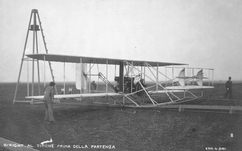
A Wright Model A poised for take-off in Italy in 1909.
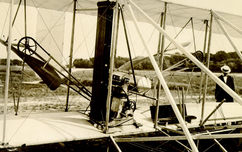
The Model A flown by Orville at Fort Myer in 1908 had the original
three-lever control system. The lever on the pilot's outside right
turned the rudder, the one to the inside right warped the wings, and
the lever on the left controlled the elevator.
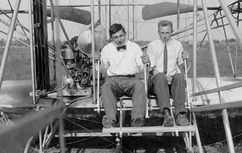
The "Orville' control system shown in this Model A at the Wright
Flight School in Montgomery, Alabama also has three levers, but only
two of them are used by any one pilot. Note that the middle lever
had a smaller lever at the top. Moving the middle lever
front-to-back warped the wings and twisting the smaller lever
side-to-side turned the rudder. The outside levers controlled the
elevator.
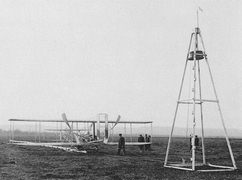
Wilbur readies a Model A for a flight in France in 1909.
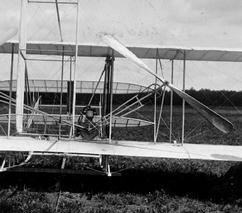
A rear view of the Model A that Wilbur flew in Europe. Note that the
propellers are not the standard "bent-end" design that typified
Wright airplanes. For a short time, Wilbur used the props from the
1904 Wright Flyer II in France. Apparently, the props that were sent
with the plane in 1907 were damaged and Orv sent these to Will for
use until a new set could be made.
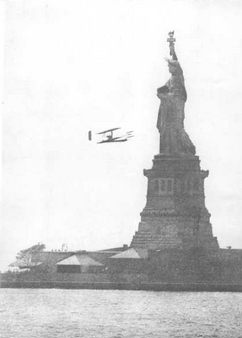
Wilbur flies the Model A around the Statue of Liberty.
|
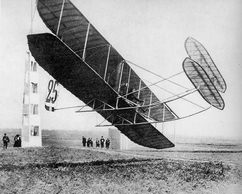
A Wright Model A flown by Eugene LeFebvre at the Rheims Air Meet in
1909.
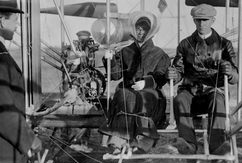
The Model A assembled and flown by Wilbur in France had just two
levers. Moving the right-hand lever front-to-back warped the wings
and side-to-side turned the rudder. The left-hand lever controlled
the elevator.
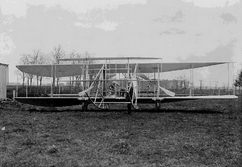
Orville demonstrates how to warp the wings of a Model A at Huffman
Prairie near Dayton, Ohio.
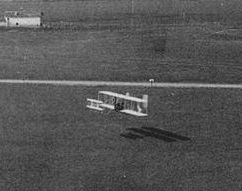
Wilbur flies a Model A in Italy in 1909. This photo was shot from a
balloon and was the first photo ever taken of an aircraft from the
air.
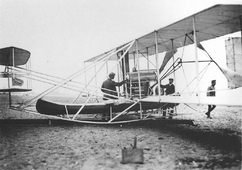
Wilbur readies his Model A to fly at the Hudson-Fulton Celebration
in New York City in 1909. The canoe strapped between the landing
skids was to serve as a pontoon should Wilbur have been forced down
in the water.
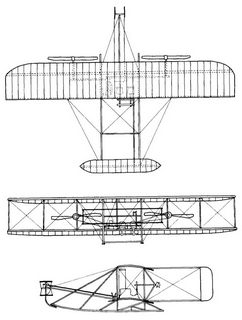
Top, front, and side drawings of the Wright Model A.
|